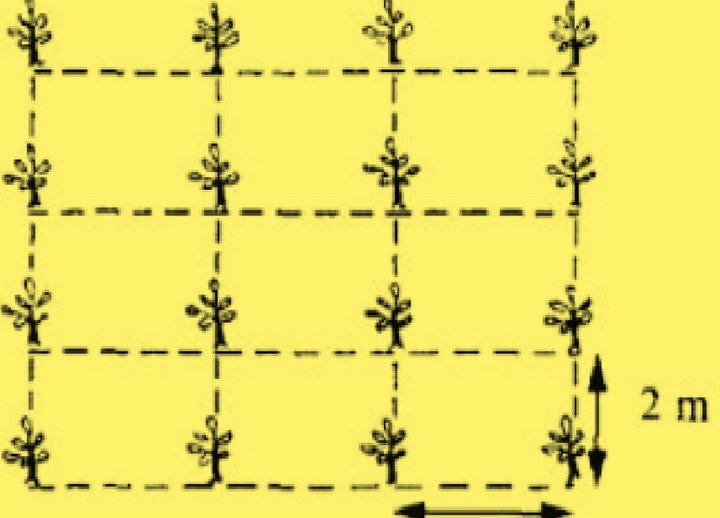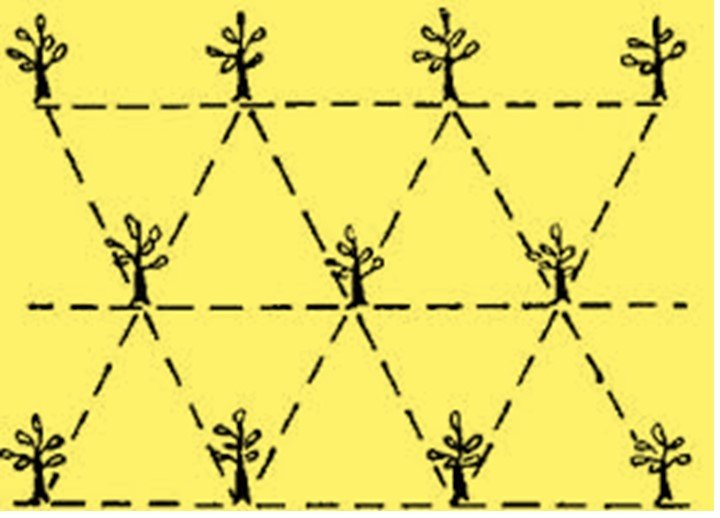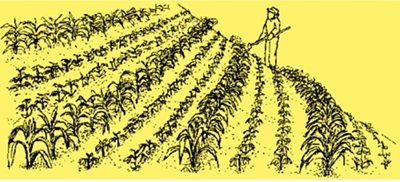Layout And Planting of Orchard

layout and planting of orchard is basic principle followed before establishment of an orchard. It gives us an clear picture about our orchard, how its looks like, how to manage, how to plant, which planting system suitable for your locality. In this article we will discuss about layout and planting of orchard.
What is a layout?
Layout means locating the position of trees, roads and buildings in the orchard being established, and systems of layout refers to the orderly ways of planting the trees.
Need of layout for orchard
Here are following reasons to layout of an orchard:
- It enables equal distribution of areas under each tree.
- It results in least wastage of land.
- Orchard operation like interculture and irrigation are carried out easily.
- It makes supervision more easy and effective.
- There is room for systematic extension of the orchard.
Points to be considered while layout and planting of orchard
- Shorter fruit trees may be assigned in the foreground and taller trees may occupy the rear. Such gradation facilitates better watching.
- Irrigated fruits should be planted close to the source of water and rainfed fruit trees be planted away from irrigation sources.
- Fruits that ripen at the same time should be in continuous blocks.
- High fertility portion of the orchard should be devoted to more paying and gross feeding fruit trees.
Various planting systems?
There are five systems of planting in which the fruit trees are commonly planted. These are as follows:
- Square system
- Rectangular system
- Hexagonal or equilateral triangle system
- Quincunx or diagonal system
- Contour system.
1-Square system:
This system of planting is the simplest and the most convenient to layout. Trees are set at the corners of a square formed by intersecting lengthwise parallel lines with crosswise parallel lines. This system of planting is commonly adopted all over India.
It has following advantages:
- Operations like ploughing, harrowing, cultivation, spraying, harvesting etc. become easy when trees are planted at equal distance from each other in regular lines
- Irrigation channels can run straight.
- Better watching of the orchard is also possible as any tres-passers can be sighted even from the other end of the orchard. .
- .

2-Rectangular system
This system is also commonly used in different parts of the world. In this the trees are planted in straight rows running at right angles. The mehtod is similar in all respects to square except that the plant to plant and row to row distances are not equal. The method of layout is similar to square system.

3-Hexagonal system
This system is also known a equilateral triangle system as the trees are planted at the corners of equilateral triangles. Six trees thus form a hexagon, with another tree at its centre. The main advantage of this system, is that by using it about 15% more trees can be planted per hectare at any given diatance than by the square system. This plan can be usefully employed where land is expensive and very fertile with good available water supply.lp

4-Quincunx or diagonal system
This system is the same as square system with the addition of a tree in the centre of each square, that is, at the points of diagonal cut. In this case, the number of trees are almost double. But the distance between the trees in the centre and at the corner is much reduced. For this reason the central tree is usually not a permanent tree and is planted just to fill the central place. This is known as a “Filler”. Filler serves as a source of additional income till the main trees come into bearing. It should be removed if it hinders the growth of main plants in any way. Obivously fillers are planted when plant to plant distance is much and the plants are expected to come into bearing after a number of years. Examples of fillers are papaya or guava in mango orchards.

5-Contour system
This system is usually followed on the hills with high slopes.

6-Distance of planting
Planting distance varies with the type of fruit plants to be grown. Tall trees like mango, litchi, sapota, are normally, grown at a distance of 10 meters. Medium tall trees like orange, guava, apple, peach, plum are grown at a distance of 5 meters, while other plants like grape, banana, pineapple, papaya are planted at a still lesser distance.